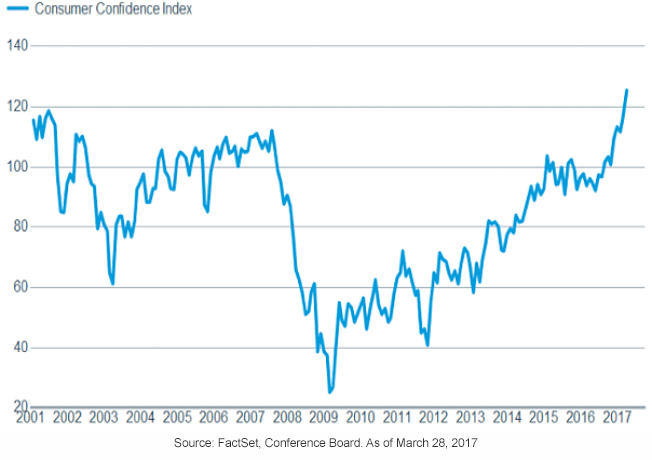Key Points:
- The modest downward pressure on stocks recently appears to be working off some overly optimistic sentiment. We view this as a healthy pause in an ongoing bull market.
- U.S. political realities and the failure of healthcare reform contributed to the recent pullback in stocks but investors shouldn’t get discouraged. Economic data has hooked up—notably business confidence, which has led to a pickup in capital spending.
- The official Brexit process has begun, and although a U.K. recession doesn’t appear imminent, risks have risen and volatility will likely rise.
Turning On the Lights
After a party is over, and the host turns on the lights, the picture often looks quite different than it did just a few minutes before. The realities of the difficulties in the U.S. political process are being recognized. This has allowed some of the sentiment froth to ease, which we believe is a healthy development. The Ned Davis Research Crowd Sentiment Poll has pulled back from excessive optimism territory, while we finally broke a 109 day streak of no 1% decline days. A pattern of two-steps-forward, half-a-step-back is healthier than if the market had maintained its melt-up status in our view.
The recent pullback was mild, but under the surface, a larger correction occurred among individual securities; potentially setting the stage for the next move higher. According to Strategas Research Group, 24% of the S&P 500 has already experienced a correction of 10-20% from their 52-week highs, while another 14% are down more than 20%.
We have recently opined that some of the optimism about the administration’s pro-growth policies may have accelerated too sharply. The failure of the Affordable Care Act (ACA) reform attempt shown light on the process that is lawmaking in the United States, and it often isn’t pretty. But investors appear heartened by the renewed focus on tax and regulatory reform.
Investors are facing the realization that “soft” data (such as consumer confidence readings and business surveys) doesn’t necessarily translate immediately into “hard” data (like retail sales, capital expenditures, and industrial production). It’s this hard data that translates into economic growth and increasing profitability. Looking at some of the parabolic moves in recent confidence surveys, it would be difficult for hard data to keep up.
There do exist some impediments to higher growth. Within housing, existing home sales fell 3.7% in February, with the National Association of Realtors noting that “buying interest is strong” but “we don’t have enough inventory to satisfy that buying interest.” That dip contrasts with the 6.1% rise in new home sales, and a strong reading in confidence from the National Association of Homebuilders.
A Tough Act to Follow
Turn the Lights Back Off!
That may be what some investors are saying after the health care debacle, exposing the inner workings of lawmaking. At this point, we don’t think the failure of healthcare reform meaningfully lessens the odds of tax reform. After licking its wounds, we think the administration and Congress will jump into the tax reform debate. Although we are optimistic about tax reform getting done, the process is likely to be complicated—especially if corporate and personal tax reform continues to be packaged together (corporate reform and/or tax cuts are arguably the lower-hanging fruit). But Schwab’s team in Washington also cautions that the timeframe is likely later in 2017; which may mean tax reform is more of a 2018 economic and earnings story.
So What?
The institutions are delivering mixed thoughts on what the rest of the year holds. Goldman Sachs told clients the market will decline the rest of the year while others remain bullish. Goldman strategist David Kostin’s year-end price target for the S&P 500 is 2,300, representing approximately a 2.6% loss from the close at the end of Q1 (March 31, 2017). “Given the late stage of the economic cycle, higher wages, inflation, and interest rates suggest that margin increases this year are unlikely,” he wrote in a note to clients. “Lower margins will translate into further negative EPS revisions in 2017,” he said.
The recent pullback in stocks and failure of the ACA repeal appears to have helped take some of the froth out of the market and correct some overly optimistic sentiment conditions. We believe this could prove to be healthy for the continuation of the bull market, with an improving economy and a still business-friendly administration supporting the potential for further gains. But potential political-induced volatility isn’t just limited to the United States, as the official Brexit process is underway. A UK recession doesn’t appear to be in the cards at this point, but risks have risen; while U.S. recession risk in the near term remains quite low.
In conclusion, and speaking of the mixed signals we are seeing, remember we never try to “time the market”. That is a losing game. What we try to do – and have a good track record of doing – is to fare well over full market cycles which include both up and down periods. Along the way we find times where we want to be cautious — and now is one of those times. There are times where it makes sense to put risk on (like late 2008 and 2009) and times where we believe it makes sense to keep risk at lower levels. That has proven to be wise over the years.
Respectfully,
Anthony L. Christensen
President

